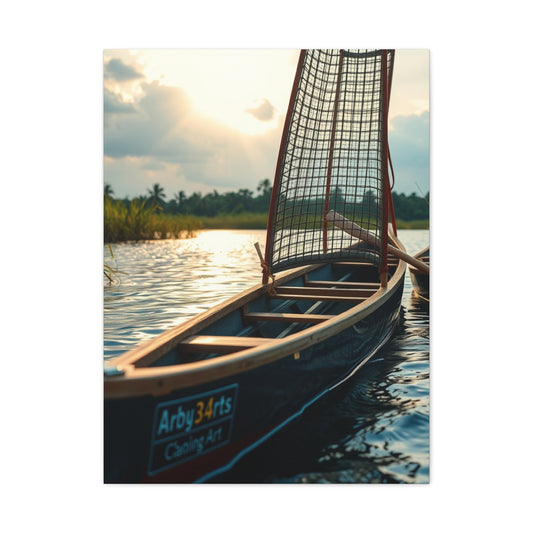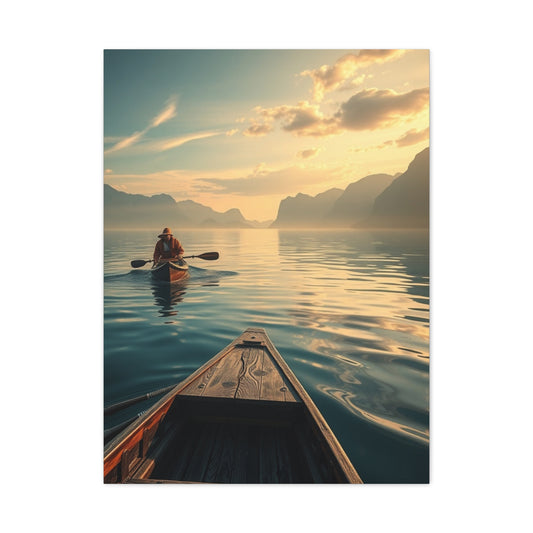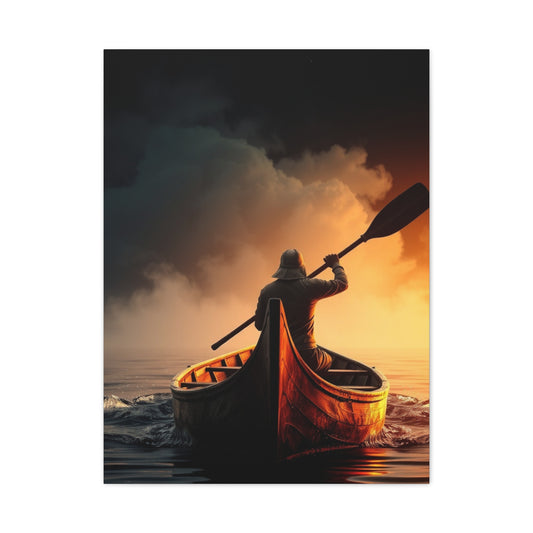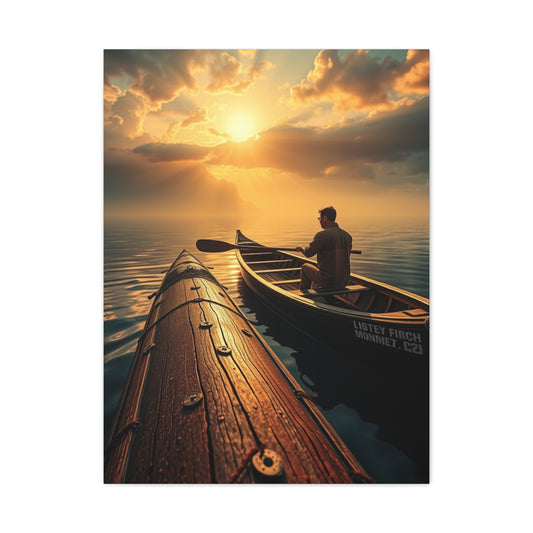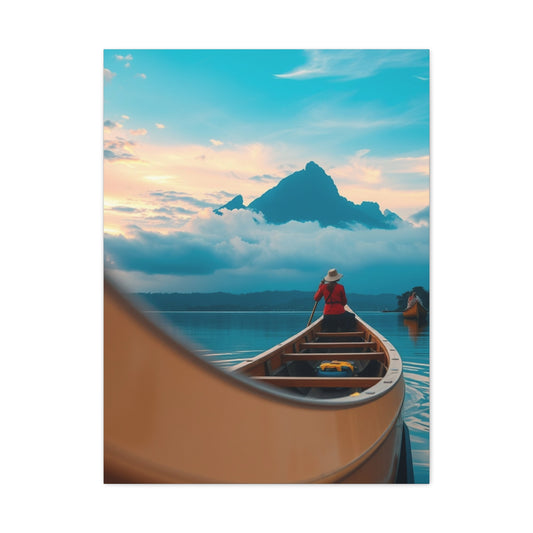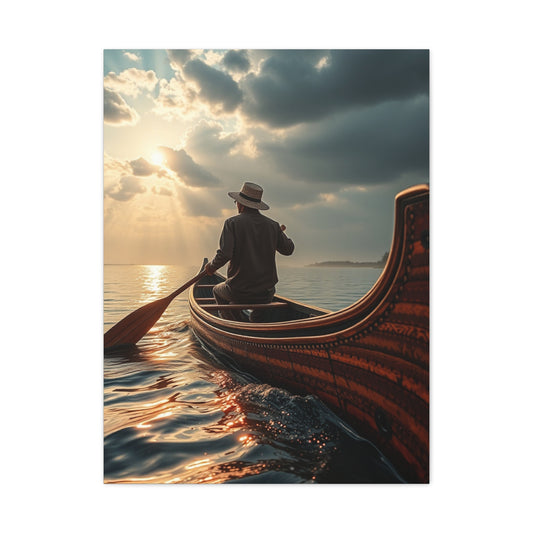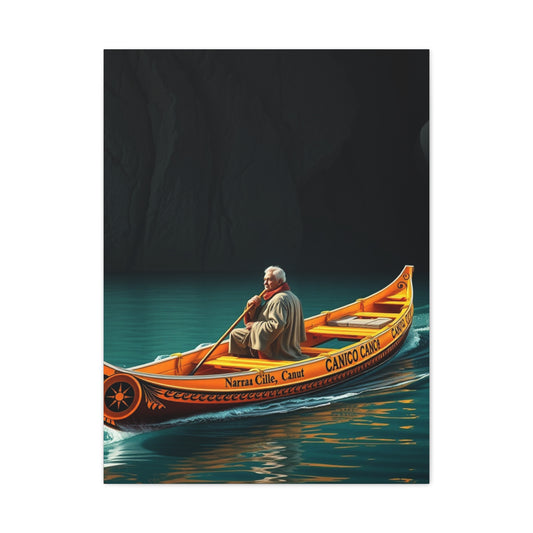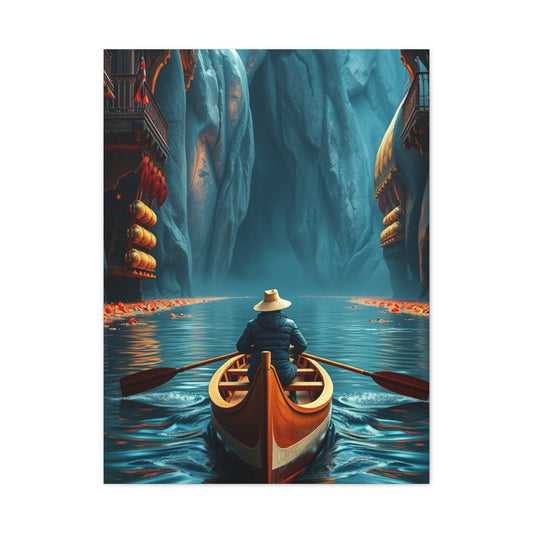Elevate Your Home with Canoe Wall Art That Celebrates Nautical Heritage and Elegance
Discovering the perfect decorative element that seamlessly blends artistic sophistication with the adventurous spirit of the great outdoors is a journey many homeowners find both exciting and challenging. In this search for interior design pieces that are not only visually appealing but also deeply meaningful, canoe wall art stands out as a truly remarkable option. By combining the elegance of handcrafted or thoughtfully designed artwork with the nostalgic charm of maritime heritage, canoe-inspired décor captures the imagination and evokes a sense of exploration, freedom, and serenity. It is more than just wall décor; it is a celebration of a lifestyle connected to waterways, nature, and timeless nautical traditions.
In contemporary interior design, there is a growing appreciation for décor that reflects personal interests, passions, and experiences. Homeowners increasingly seek pieces that tell a story or spark a sense of wonder, rather than simply filling empty wall space. Canoe wall art offers a compelling intersection of these desires, bringing together visual beauty, craftsmanship, and a symbolic connection to adventure and travel. Whether it is a sleek modern interpretation featuring minimalist lines or a vintage-style piece with rustic wooden textures, canoe art resonates with those who value both aesthetic refinement and the evocative power of maritime imagery.
The rising popularity of maritime-inspired décor can be attributed to several factors. Water, in its many forms, has long been associated with calm, reflection, and rejuvenation, making aquatic themes an ideal complement to spaces meant for relaxation and comfort. Additionally, the timeless appeal of nautical craftsmanship, whether in traditional wooden canoes, painted designs, or metalwork, adds a layer of authenticity and artisanal quality to any room. By incorporating canoe wall art, homeowners can achieve a balance between elegance and adventure, creating interiors that feel both sophisticated and inviting.
Canoe wall art is also highly versatile, capable of enhancing a wide range of design styles. In coastal or beach-themed interiors, it reinforces the nautical narrative, while in rustic cabins or modern urban lofts, it introduces an unexpected element that draws the eye and sparks conversation. Color palettes can vary from natural wood tones that evoke a sense of rugged authenticity to painted or metallic finishes that add contemporary flair. Placement is equally flexible—above a sofa, as part of a gallery wall, or even in hallways and entryways, a well-chosen canoe piece transforms ordinary walls into captivating focal points.
Ultimately, canoe wall art goes beyond mere decoration; it bridges the gap between art, storytelling, and lifestyle. It invites viewers to reflect on the serenity of gliding across water, the thrill of exploration, and the enduring beauty of maritime craftsmanship. By thoughtfully integrating such pieces into their homes, individuals not only enhance the visual appeal of their living spaces but also celebrate personal passions, timeless traditions, and the enchanting allure of the water.
Maritime Watercraft Decorations
The allure of waterborne vessel artwork extends far beyond simple decorative preference; it represents a profound connection to exploration, freedom, and humanity’s enduring relationship with aquatic environments. From the elegance of a canoe gliding across a glassy lake to the historical charm of vintage sailing ships, these artistic representations serve as powerful reminders of adventure, tranquility, and the breathtaking beauty of waterways across the globe. They capture the imagination while providing a sense of calm, inviting viewers to reflect on journeys past, present, and future.
Professional interior designers often emphasize the importance of integrating décor that reflects personal interests and lifestyle aspirations. Maritime-themed artwork, particularly pieces featuring traditional paddling vessels, creates immediate visual interest while establishing a subtle yet evocative connection to nature. A single canoe illustration or a cluster of watercraft-inspired pieces can transport a room’s occupants to serene lake mornings, wilderness expeditions, or quiet river journeys. The gentle rhythm of paddle strokes against calm waters, translated into artistic forms, evokes a meditative quality that resonates deeply within living spaces.
The psychological impact of nautical decorations goes far beyond their visual appeal. Studies in environmental psychology suggest that imagery associated with water and exploration can foster feelings of serenity, inspiration, and connectedness to the natural world. Incorporating maritime artwork into home interiors therefore not only enhances aesthetic value but also contributes to emotional well-being. Whether displayed in a living room, study, or hallway, these pieces encourage relaxation, reflection, and imaginative engagement, making them particularly effective in creating spaces that feel both inviting and rejuvenating.
Contemporary homeowners increasingly seek unique decorative elements that do more than merely occupy wall space. They want pieces that spark conversation, convey personality, and reflect an individual’s passions. Vintage-inspired patent illustrations, for example, combine historical significance with artistic sophistication, offering an elegant way to celebrate maritime innovation, craftsmanship, and heritage. These prints, often detailed with technical precision and classic design aesthetics, can serve as focal points or complementary accents within diverse interior styles—from rustic cabins and coastal retreats to modern minimalist homes.
Maritime watercraft decorations are versatile, capable of blending seamlessly with a variety of design approaches. They offer a bridge between history, adventure, and art, appealing to both seasoned collectors and casual enthusiasts alike. By thoughtfully selecting pieces that resonate with personal tastes, homeowners can create curated displays that evoke narrative, emotion, and timeless style. Ultimately, these decorations transcend mere wall adornment, transforming interiors into immersive environments that celebrate exploration, natural beauty, and the enduring allure of waterborne vessels.
Nautical Elegance at Home
Gaining a deeper understanding of the technical characteristics that differentiate various types of paddling vessels not only enriches appreciation for their craftsmanship but also highlights their historical and cultural significance. These distinctions reveal how careful engineering, environmental adaptation, and practical functionality converged over centuries to shape the watercraft we recognize today. Each design reflects thoughtful consideration of stability, performance, and utility, tailored to specific waterways, climates, and human activities.
Traditional open-hull paddling vessels are celebrated for their distinctive structural features, which prioritize stability, cargo capacity, and maneuverability. Often characterized by elongated profiles, gently tapered ends, and elevated sides, these vessels achieve efficient displacement patterns that allow smooth navigation across rivers, lakes, and coastal waters. Their generous interior space accommodates passengers, supplies, and equipment, making them ideal for extended journeys or trade expeditions. These design principles emerged from centuries of cultural knowledge, with indigenous and local communities refining hull shapes, materials, and weight distribution to optimize performance for their specific environments.
In contrast, modern recreational paddling vessels reflect a balance between stability, speed, and versatility. Typically ranging from thirteen to seventeen feet in length, these crafts are engineered to offer both performance and ease of handling. Open-deck configurations provide convenient access for paddlers and allow for efficient loading and unloading of gear, making them suitable for both solo excursions and group adventures. Innovations in hull design, such as slightly rounded or flat-bottomed profiles, enhance tracking and stability, ensuring that modern paddlers can navigate diverse conditions with confidence and control.
The materials used in vessel construction have also undergone a remarkable evolution. Traditional paddling craft relied on natural materials such as birchbark, cedar, or solid timber, selected for their lightweight properties, flexibility, and availability. Contemporary vessels, however, benefit from advanced manufacturing techniques and high-performance materials. Fiberglass, aluminum, and specialized plastics offer superior durability, low maintenance, and improved hydrodynamic efficiency, allowing watercraft to perform reliably across a range of conditions.
For homeowners and interior design enthusiasts, these vessels serve as more than functional watercraft—they inspire elegant decorative pieces. Elevate your home with canoe wall art that celebrates nautical heritage and elegance, drawing upon the rich history and craftsmanship of paddling vessels. By incorporating art that reflects the structural beauty and timeless appeal of traditional and modern canoes, living spaces can be transformed into serene, inspiring environments that pay homage to maritime adventure while enhancing aesthetic sophistication. Canoe wall art bridges the gap between technical innovation and artistic expression, creating décor that resonates both visually and emotionally.
Understanding the technical distinctions between traditional and modern paddling vessels provides insight into how human ingenuity and cultural practices have influenced watercraft design. From handcrafted open-hull canoes built for endurance and utility to lightweight, precision-engineered recreational models, each vessel tells a story of adaptation, innovation, and functional artistry, which can now also be celebrated in stylish, nautical-inspired home décor.
Nautical Canoe Wall Décor Ideas
Incorporating nautical canoe wall décor into your home is a creative way to celebrate maritime heritage while adding a unique focal point to any room. Canoe-inspired pieces bring a sense of adventure and serenity, evoking the calm of gliding across tranquil lakes or exploring winding rivers. Whether you choose vintage wooden models, sleek modern designs, or artistic representations in metal or canvas, these decorations add both texture and personality to your walls. Displaying a single statement canoe above a sofa can create an elegant, minimalist effect, while arranging multiple pieces in a gallery-style layout brings dynamic energy and visual interest.
Complementing these installations with natural elements such as driftwood, rope accents, or ocean-inspired color palettes enhances the nautical theme, creating a cohesive and inviting space. From coastal cottages to contemporary urban apartments, nautical canoe wall décor offers endless possibilities to merge functional artistry with timeless maritime charm, making your home both stylish and evocative of the spirit of exploration.
Bringing Maritime Heritage Indoors
Canoe wall art does more than simply decorate a space—it embodies a deep connection to maritime tradition, craftsmanship, and the spirit of exploration. Canoes have long been a symbol of travel, adventure, and human ingenuity, serving as vessels that carried communities across rivers, lakes, and coastlines for centuries. By bringing this imagery into interior design, homeowners and collectors are not only adding aesthetic value but also paying tribute to a rich cultural legacy that spans multiple regions and histories.
One of the remarkable qualities of canoe-inspired wall art is its versatility in style and interpretation. For those who prefer authenticity, vintage wooden canoe replicas or wall-mounted cross-sections can create a rustic, heritage-focused atmosphere. These pieces often highlight the skillful joinery, wood grain, and patina of traditional craftsmanship, which can make a home feel grounded in history. On the other hand, contemporary interpretations—such as abstract canoe silhouettes painted on canvas, metallic sculptures, or minimalist line art—bring a modern, sophisticated flair while still referencing the timeless essence of waterborne journeys.
The emotional resonance of canoe wall art lies in its ability to evoke calmness and nostalgia. For many, it conjures memories of summer adventures on tranquil lakes, paddling through winding rivers, or quiet moments spent in nature. This makes it particularly suited for spaces where relaxation and reflection are encouraged, such as living rooms, reading nooks, or bedrooms. When paired with earthy textures like driftwood accents, sisal rugs, or woven baskets, the aesthetic becomes even more cohesive, echoing the harmony between human activity and natural landscapes. Adding fabrics like soft linen or muted cotton further enhances the coastal or lakeside vibe, creating an environment that feels both welcoming and timeless.
Canoe wall art can also serve as a storytelling element within a home. For example, a family that enjoys kayaking or canoeing together might display a custom piece that reflects personal memories of their favorite waterways. In this way, the art becomes not only decorative but also deeply personal, turning walls into living narratives of shared experience and heritage.
Ultimately, bringing maritime heritage indoors through canoe wall art blends tradition with creativity. It allows modern interiors to capture the adventurous spirit of the past while fostering a serene, contemplative atmosphere. Whether chosen for historical significance, artistic value, or emotional connection, canoe-themed art pieces transform ordinary walls into immersive reflections of water, travel, and timeless craftsmanship.
Timeless Canoe Wall Décor for Modern Interiors
Modern interior design has evolved into more than just a visual arrangement of furniture and color schemes—it has become a way to tell stories, express individuality, and create immersive environments. Canoe wall décor represents this marriage of style and storytelling, offering a piece of art that embodies tradition, adventure, and serenity while blending seamlessly with contemporary living spaces.
One of the most captivating aspects of canoe wall décor is its versatility. Sleek, minimalistic canoe silhouettes in muted tones or metallic finishes can elevate the atmosphere of an industrial loft or an urban apartment, where clean lines and understated elegance are key. The reflective nature of metallic finishes, such as brushed silver or bronze, adds sophistication while still maintaining a sense of natural connection to water and outdoor exploration. On the other hand, larger wooden canoe models—with their visible grain patterns and warm tones—fit beautifully in rustic cabins, lake houses, or coastal homes, where natural materials and organic textures enhance the feeling of harmony with the surrounding environment.
Designers and homeowners alike are increasingly using canoe décor as a focal point within a room. A single elongated canoe hung horizontally above a sofa or bed can serve as a dramatic centerpiece, drawing the eye and sparking conversation. Alternatively, arranging several smaller canoe-inspired pieces in staggered or geometric patterns creates a sense of rhythm and movement, echoing the fluidity of water and the gentle motion of paddling. This approach transforms a plain wall into a gallery-like installation, bringing both structure and artistic flair into the space.
Beyond aesthetics, canoe wall décor also brings a deeper emotional resonance. Canoes have long been associated with exploration, craftsmanship, and the human connection to nature. Displaying them indoors not only highlights their artistic beauty but also symbolizes a spirit of adventure, resilience, and simplicity. For many, it evokes memories of peaceful river journeys, lakeside retreats, or family vacations, making the décor both personal and meaningful.
Styling choices can further enhance its impact. Pairing canoe wall art with natural materials like rattan, linen, and reclaimed wood emphasizes a warm, organic atmosphere, while coupling it with glass, steel, or concrete surfaces highlights the contrast between tradition and modernity. Accent lighting, such as subtle spotlights or backlit installations, can also add depth and drama, ensuring the piece remains a striking element both day and night.
In essence, canoe wall décor bridges past and present. It carries forward a timeless narrative rooted in heritage and craftsmanship while adapting to the sleek lines and bold statements of modern design. Whether used as a subtle accent or a dramatic showpiece, it offers a unique way to infuse interiors with elegance, storytelling, and enduring nautical charm.
Vintage Canoe Art: Adding Character to Your Space
Vintage canoe art carries with it a timeless quality that effortlessly combines nostalgia, craftsmanship, and storytelling. Unlike modern minimalist pieces, which focus primarily on clean lines and abstraction, vintage-inspired canoe décor draws deeply from history and tradition. These artworks often depict early 20th-century paddling vessels, antique canoe patents, or hand-painted illustrations that showcase the rugged beauty of exploration and the spirit of outdoor adventure. By displaying such pieces in your home, you not only bring in a striking decorative element but also introduce a sense of narrative—one that connects viewers to stories of rivers, lakes, and the romance of discovery.
One of the most appealing aspects of vintage canoe art is its versatility in evoking different moods depending on how it is styled. For example, a framed patent print of an old canoe design can lend an academic and intellectual quality to a study or library. It invites curiosity, sparking conversations about the ingenuity of craftsmanship from another era. Similarly, hand-painted illustrations of paddlers navigating serene waters can add a more personal, human touch, evoking feelings of peace, resilience, and connection with nature. When displayed in living areas, these pieces often become conversation starters, drawing guests into stories of adventure and history.
The placement and styling of vintage canoe art can greatly influence the atmosphere of a room. In a study or library, pairing the artwork with leather-bound books, antique globes, or nautical maps enhances the scholarly, old-world aesthetic. Muted color palettes—such as earthy browns, deep greens, and soft blues—further emphasize the vintage charm, creating an environment that feels warm, grounded, and full of character. In a rustic or cabin-inspired setting, a larger wall-mounted illustration of a classic wooden canoe can anchor the entire room, reinforcing a sense of heritage and authenticity.
Beyond studies and libraries, vintage canoe art also integrates beautifully into living rooms, dens, or even hallways. When paired with textured fabrics such as tweed or wool, or furniture pieces made from reclaimed wood, the artwork adds an extra layer of authenticity and coziness. In modern interiors, where clean lines and neutral tones dominate, vintage canoe pieces can serve as an unexpected yet delightful contrast. A framed sepia-toned print hung above a minimalist sofa or against a crisp white wall creates an intriguing blend of old and new, highlighting the timeless relevance of such art.
The symbolic meaning behind canoe imagery adds even more depth to its decorative appeal. Canoes historically represent journeys, both physical and metaphorical. They evoke exploration, independence, and resilience—values that resonate with many people seeking grounding in their personal spaces. By incorporating vintage canoe art into your interiors, you invite these symbolic qualities into your home. For individuals who cherish the outdoors, water travel, or family heritage tied to lakeside adventures, such art becomes more than decoration; it transforms into a personal statement and a source of emotional connection.
Collectors and design enthusiasts often appreciate that vintage canoe art can take many forms, ranging from detailed patent drawings to painterly watercolors, rustic wood carvings, or even repurposed canoe fragments used as decorative accents. This diversity allows homeowners to select pieces that align with their preferred aesthetic—whether they lean toward the scholarly, the rustic, or the romantic. Some may even choose to create gallery walls that mix different interpretations of canoe imagery, layering history, artistry, and narrative into a single curated space.
Ultimately, vintage canoe art does more than simply adorn walls. It adds depth, authenticity, and a sense of story that few other decorative pieces can match. By thoughtfully incorporating these artworks into spaces such as studies, libraries, or cozy living areas, you cultivate an atmosphere that is rich in character and history. Paired with complementary décor like nautical maps, leather furniture, and muted color palettes, the result is a warm and welcoming environment—one that feels both timeless and deeply personal.
DIY Canoe Wall Displays: Creative and Personalized Touches
For those who enjoy hands-on projects and love adding character to their living space, DIY canoe wall displays present an exciting opportunity to blend creativity, personalization, and craftsmanship. Unlike store-bought décor, these handmade displays tell a story about the maker, offering not only visual appeal but also a sense of authenticity that reflects individual style and ingenuity. By experimenting with materials such as repurposed paddles, miniature canoe models, or reclaimed wood, homeowners can create wall art that feels both meaningful and unique.
One of the most approachable starting points is repurposing old paddles. Vintage wooden paddles can be sanded, polished, and either painted or stained to suit your interior aesthetic. They work beautifully in rustic, nautical, or cabin-inspired homes. For a more artistic approach, paddles can be decorated with geometric designs, tribal patterns, or even personalized with initials or family crests. Arranging them in symmetrical rows, a starburst pattern, or as a crisscrossed focal piece instantly brings charm to any wall. This not only honors maritime traditions but also turns simple utilitarian objects into stylish art.
Miniature canoe replicas are another versatile element. These can be mounted as standalone centerpieces or grouped together to form a gallery wall. Small-scale models bring craftsmanship to the forefront, showcasing fine detailing that invites closer inspection. For a modern twist, these replicas can be placed inside shadow boxes with backlighting, creating a museum-like display. This approach adds depth to the wall and elevates the piece from decoration to conversation starter.
Incorporating reclaimed wood into your canoe-themed décor provides texture and sustainability. Old planks from barns, docks, or boats can serve as mounting backdrops for paddles or small canoe art. The weathered look of aged wood brings a sense of history, reinforcing the nautical theme while also aligning with eco-friendly design practices. Staining or painting the reclaimed wood can help tie the display into your existing color scheme, making the installation feel both intentional and stylish.
For those wanting to push creativity further, integrating lighting elements adds dramatic flair. Strategically placed LED strips or warm Edison bulbs can highlight the contours of mounted paddles or illuminate canoe models, creating visual contrast during evening hours. Lighting not only enhances the artwork but also contributes to the overall ambiance of the room. For instance, a softly lit canoe paddle arrangement above a fireplace can create a cozy, inviting atmosphere.
DIY canoe wall displays also allow for experimentation with scale and layout. A single oversized paddle can serve as a bold statement piece, while clusters of smaller items create dynamic visual interest. Mixing textures—such as combining wood, metal, and canvas—adds depth and richness to the arrangement. Even incorporating natural elements like rope, fishing nets, or stones can reinforce the maritime aesthetic while keeping the look grounded and authentic.
Strategic Placement Principles for Watercraft Artwork
The optimal positioning of maritime-themed wall art requires understanding of visual weight, sight lines, and spatial relationships within interior environments. Proper placement enhances both the artwork's impact and the overall room composition.
Central focal points work exceptionally well for detailed technical illustrations that reward close examination. These positions allow viewers to appreciate fine details while ensuring the artwork commands appropriate attention within the space.
Scale relationships between artwork and surrounding elements significantly impact visual effectiveness. Properly proportioned pieces create harmonious compositions while oversized or undersized elements can disrupt spatial balance and reduce overall aesthetic impact.
Lighting considerations become particularly important for detailed technical illustrations that contain fine lines and intricate details. Appropriate illumination enhances readability while preventing glare or shadows that might obscure important visual elements.
Grouping strategies can create dynamic wall compositions that tell cohesive stories about maritime heritage, exploration, or watercraft evolution. Careful spacing and alignment ensure individual pieces maintain their integrity while contributing to larger narrative themes.
Complementary Decorative Elements for Maritime Themes
Building comprehensive nautical design schemes requires selecting accessories and complementary artwork that enhance rather than overwhelm the primary focal pieces. Successful coordination creates layered, sophisticated environments that feel authentic and well-considered.
Textile selections provide opportunities to reinforce maritime themes through pattern, color, and texture choices. Rope details, canvas materials, and traditional nautical patterns can subtly support the overall design concept without becoming visually dominant.
Natural elements including driftwood, shells, and stone accents connect interior spaces to coastal environments while providing textural variety. These organic components should appear naturally placed rather than obviously arranged for decorative effect.
Vintage or reproduction maritime instruments add functional beauty while reinforcing nautical themes. Compasses, barometers, and navigation tools serve as conversation pieces while demonstrating authentic maritime heritage.
Lighting fixtures inspired by maritime traditions can significantly enhance nautical atmospheres. Lantern designs, rope-wrapped elements, and weathered metal finishes provide period-appropriate illumination while supporting overall design cohesion.
Understanding Quality Considerations in Decorative Artwork
Evaluating potential wall art purchases requires understanding construction quality, material durability, and long-term value considerations. These factors significantly impact both immediate satisfaction and ongoing ownership experience.
Material quality affects both visual appeal and longevity expectations. Premium substrates, archival printing processes, and quality framing materials ensure artwork maintains its appearance throughout years of display while protecting the underlying image from degradation.
Construction techniques influence both aesthetic presentation and structural integrity. Precision cutting, accurate assembly, and quality finishing work contribute to professional appearances that enhance perceived value and complement sophisticated interior environments.
Framing considerations significantly impact both protective functionality and visual presentation. Quality frames provide proper image support while enhancing rather than competing with the artwork itself. Custom framing options allow precise coordination with existing interior elements.
Size specifications should align with intended placement locations and surrounding furnishings. Properly scaled pieces create appropriate visual impact while maintaining harmonious relationships with nearby elements and overall room proportions.
Contemporary Art Pieces
Modern production methods enable creation of detailed, durable artwork that captures intricate technical illustrations with remarkable precision. Understanding these processes helps buyers appreciate quality differences and make informed purchasing decisions.
Laser cutting technology allows extremely precise reproduction of complex line work and detailed patterns. This manufacturing approach creates crisp, clean edges while maintaining consistent accuracy across multiple production runs, ensuring each piece meets quality standards.
Material selection significantly impacts both appearance and durability characteristics. Baltic birch provides excellent stability, attractive grain patterns, and consistent machining properties that support precision manufacturing while creating beautiful finished products.
Finishing processes protect underlying materials while enhancing visual appeal. Light staining techniques highlight natural wood characteristics while providing subtle color enhancement that complements various interior design schemes without overwhelming existing color palettes.
Quality control procedures ensure consistent production standards and identify potential defects before shipping. Established manufacturers implement systematic inspection processes that maintain reputation and customer satisfaction through reliable quality delivery.
Installation and Display Considerations for Wall Artwork
Proper installation techniques ensure both artwork security and wall protection while optimizing visual presentation. Understanding these requirements helps buyers prepare appropriate display locations and avoid common installation problems.
Wall preparation involves identifying appropriate mounting points and ensuring adequate support for artwork weight and dimensions. Stud locations provide optimal security for heavier pieces while hollow wall anchors can accommodate lighter installations in convenient locations.
Hardware selection should match both artwork requirements and wall construction characteristics. Quality hanging systems distribute weight evenly while providing adjustment capabilities that enable precise positioning and leveling.
Environmental considerations include avoiding locations with excessive moisture, direct sunlight, or significant temperature fluctuations that might damage artwork over time. Proper positioning protects investment while ensuring long-term enjoyment.
Maintenance requirements for quality artwork are typically minimal but should be understood to preserve appearance and value. Regular dusting and occasional inspection ensure problems are identified and addressed before causing significant damage.
Customization Options for Personalized Artwork Experiences
Many manufacturers offer customization services that enable buyers to create unique pieces tailored to specific preferences, spatial requirements, or design themes while maintaining quality standards and aesthetic appeal.
Size modifications accommodate diverse installation requirements and spatial constraints while preserving artistic proportions and visual impact. Custom dimensions ensure optimal fit within intended locations without compromising design integrity.
Framing options provide opportunities to coordinate with existing interior elements while protecting artwork and enhancing presentation quality. Material choices, color selections, and style variations enable precise integration with established design schemes.
Color modifications can adapt artwork to specific interior palettes while maintaining historical accuracy and artistic integrity. Subtle adjustments often provide necessary coordination without compromising the piece's authentic character.
Text customization allows incorporation of personal information, commemorative details, or specific historical references that create meaningful connections between artwork and owners' experiences or interests.
Seasonal Decorating Integration with Maritime Themes
Maritime artwork and nautical decorative elements offer exceptional versatility for seasonal decorating approaches that maintain cohesive design themes while acknowledging changing seasons and holiday celebrations.
Summer integration emphasizes bright, fresh maritime elements that complement warm weather lifestyles and outdoor activity increases. Lighter color palettes and breezy textures enhance the natural connection between nautical themes and summer enjoyment.
Winter applications focus on cozy, protective aspects of maritime heritage including sheltered harbors, warm lighthouses, and sturdy vessels weathering storms. These themes provide comfort and security associations during cold weather periods.
Spring renewal connects with maritime themes through imagery of emerging navigation seasons, vessel preparation activities, and the renewal of water-based recreation opportunities after winter dormancy periods.
Autumn integration emphasizes harvest themes, preparation activities, and the contemplative aspects of maritime life during quieter seasons when vessels return to protected harbors and communities prepare for winter challenges.
Maintenance and Preservation Strategies for Artwork Longevity
Proper care techniques ensure maritime artwork maintains its appearance and value throughout years of display while minimizing maintenance requirements and preservation costs.
Environmental control involves maintaining appropriate temperature and humidity levels while avoiding exposure to direct sunlight, excessive moisture, or significant temperature fluctuations that might damage materials or cause fading.
Cleaning procedures should utilize gentle techniques and appropriate materials that remove accumulated dust and debris without damaging surfaces or finishes. Regular maintenance prevents buildup that might require more aggressive cleaning methods.
Inspection schedules enable early detection of potential problems including frame damage, mounting system wear, or surface deterioration that might progress if left unaddressed. Proactive maintenance prevents minor issues from becoming major problems.
Professional conservation services provide expertise for addressing serious damage or implementing preventive measures that exceed typical homeowner capabilities. These services protect valuable pieces while maintaining their aesthetic and monetary value.
Gift-Giving Applications for Maritime Artwork
Maritime-themed artwork provides exceptional gift opportunities for various occasions and recipients who appreciate nautical heritage, outdoor adventures, or distinctive interior design elements.
Housewarming gifts benefit from maritime artwork's universal appeal and ability to enhance diverse interior design schemes while providing conversation pieces that reflect thoughtful selection and personal attention to recipient preferences.
Anniversary celebrations can incorporate maritime themes that symbolize shared adventures, travel experiences, or mutual appreciation for nautical heritage and water-based activities that couples have enjoyed together.
Retirement gifts often emphasize leisure activities and personal interests that retirees plan to pursue. Maritime artwork appeals to those planning boat ownership, coastal living, or increased outdoor recreation participation.
Professional recognition applications include maritime artwork for individuals whose careers involve water transportation, coastal engineering, maritime law, or related fields where nautical themes provide meaningful professional connections.
Regional Variations in Maritime Artistic Traditions
Different geographic regions have developed distinctive approaches to maritime artwork that reflect local waterways, vessel types, cultural traditions, and artistic preferences that create unique aesthetic characteristics.
Great Lakes traditions emphasize freshwater navigation, commercial shipping heritage, and the distinctive vessel types developed for inland waterway transportation. These themes reflect the unique maritime culture of North America's inland seas.
Coastal traditions focus on ocean-going vessels, fishing heritage, and the dramatic relationship between human communities and powerful oceanic forces. These artistic approaches often emphasize both beauty and danger inherent in maritime life.
River cultures celebrate the gentler aspects of waterway navigation including recreation, transportation, and the peaceful qualities of flowing water environments. These traditions often emphasize harmony between human activity and natural systems.
Arctic maritime traditions highlight the specialized technologies and exceptional skills required for navigation in challenging polar conditions. These artistic approaches often emphasize human ingenuity and adaptation to extreme environments.
Maritime Art Production
Modern manufacturing technologies enable creation of maritime artwork that combines traditional aesthetic appeal with contemporary production capabilities, quality standards, and customization options.
Computer-aided design systems allow precise reproduction of historical technical illustrations while enabling modifications, scaling, and customization that would be difficult or impossible using traditional production methods.
Digital printing technologies provide exceptional color accuracy and detail reproduction while offering durability characteristics that exceed many traditional printing processes. These capabilities ensure artwork maintains its appearance throughout extended display periods.
Automated cutting systems enable complex shapes and intricate details to be reproduced consistently across multiple production runs while maintaining tight tolerances and quality standards that support professional presentations.
Quality assurance systems incorporate digital inspection technologies that identify defects and ensure consistency while reducing human error and maintaining customer satisfaction through reliable quality delivery.
Future Trends in Maritime Decorative Art
Emerging trends in maritime artwork reflect changing lifestyle preferences, technological capabilities, and cultural attitudes toward nautical heritage and water-based recreation activities.
Personalization options continue expanding as manufacturing technologies enable cost-effective customization that allows buyers to create unique pieces tailored to specific preferences, spatial requirements, or personal connections to maritime activities.
Sustainability considerations increasingly influence material selection and production processes as environmentally conscious consumers seek artwork that reflects their values while maintaining aesthetic appeal and quality standards.
Interactive elements may incorporate digital technologies that provide additional information, historical context, or multimedia experiences that enhance traditional static artwork presentations while maintaining visual appeal.
Collectibility factors continue developing as maritime artwork gains recognition for both aesthetic merit and historical significance, creating market dynamics that support quality production and long-term value appreciation.
Conclusion:
The integration of canoe wall art and other maritime-themed decorative elements into contemporary living spaces represents far more than simple aesthetic enhancement. These carefully selected pieces serve as bridges connecting modern lifestyles with humanity's enduring relationship to aquatic environments, exploration, and the timeless appeal of watercraft craftsmanship.
Throughout this comprehensive exploration, we have discovered how maritime artwork transcends mere decoration to become meaningful expressions of personal values, lifestyle aspirations, and cultural appreciation. The psychological benefits of nautical imagery, from stress reduction to adventure inspiration, demonstrate how thoughtful design choices can positively impact daily well-being and environmental satisfaction.
The historical significance of patent illustrations and technical drawings provides educational opportunities that enrich understanding while creating sophisticated conversation pieces. These documents preserve innovation heritage while celebrating human ingenuity in overcoming aquatic transportation challenges. Their detailed craftsmanship and historical context make them particularly valuable for those who appreciate both artistic beauty and technological achievement.
Quality considerations in artwork selection ensure long-term satisfaction and value retention while supporting appreciation for skilled craftsmanship and authentic materials. Understanding manufacturing processes, material characteristics, and construction techniques enables informed purchasing decisions that balance aesthetic preferences with practical considerations including durability, maintenance requirements, and installation specifications.
The versatility of maritime themes in interior design applications provides exceptional flexibility for various spaces, decorating styles, and seasonal variations. Whether incorporated into coastal-themed living areas, professional office environments, or casual recreational spaces, nautical elements bring sophistication and character that enhance rather than overwhelm existing design elements.
Regional variations in maritime artistic traditions offer opportunities to celebrate specific cultural heritage, geographic connections, or personal experiences with particular waterway systems. Great Lakes imagery resonates with inland water enthusiasts while coastal themes appeal to ocean lovers, demonstrating how maritime artwork can reflect individual backgrounds and interests.
Investment perspectives on quality maritime artwork reveal potential for both aesthetic satisfaction and financial appreciation, particularly for pieces demonstrating exceptional craftsmanship, historical significance, or limited availability. Proper care and maintenance practices protect these investments while ensuring continued enjoyment throughout years of display.
The educational value inherent in technical patent illustrations combines multiple learning opportunities within single presentations. These pieces develop technical literacy while providing historical perspective and artistic appreciation that appeals to diverse interests and age groups. Such multifaceted appeal makes maritime artwork particularly valuable for family environments and educational settings.
Customization options enable creation of personalized pieces that reflect specific preferences while maintaining quality standards and authentic character. Size modifications, framing choices, and color adaptations allow precise integration with existing interior design schemes without compromising artistic integrity or historical accuracy.
Future trends in maritime decorative art promise continued evolution in personalization options, sustainability considerations, and interactive capabilities while maintaining the fundamental appeal of nautical themes and traditional craftsmanship values. These developments ensure maritime artwork remains relevant and appealing to evolving consumer preferences and lifestyle requirements.
The strategic placement principles and complementary decorative elements discussed throughout this exploration provide practical guidance for creating cohesive, sophisticated maritime-themed environments. Understanding visual relationships, lighting considerations, and material coordination ensures successful integration that enhances both individual pieces and overall spatial compositions.

